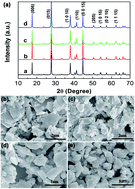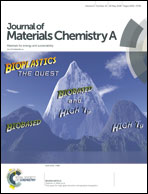High thermoelectric performance of n-type Bi2Te2.7Se0.3via nanostructure engineering†
Abstract
BiSbTe has been realized as an ideal p-type thermoelectric material near room temperature; however, its commercial applications are largely restricted by its n-type counterpart that exhibits relatively inferior thermoelectric performance. In this work, n-type BiTeSe based composites Bi2Te2.7Se0.3–f InSb (0 ≤ f ≤ 2.5 vol%) are prepared by a ball milling and spark plasma sintering method. A record-high ZT value of ∼1.22 is achieved at 323 K for Bi2Te2.7Se0.3–1.5 vol% InSb composites. This significant enhancement in thermoelectric performance is attributed to the incorporation of nanostructured InSb into the Bi2Te2.7Se0.3 matrix, which can simultaneously modulate the electrical and thermal transport. InSb with high carrier mobility precipitated in the matrix can strengthen interface scattering at the phase boundaries, which can effectively scatter the heat-carrying phonons and thus yield an extremely low lattice thermal conductivity, while the high power factor is maintained. As a result, a maximum ZT of 1.22 is obtained. The average ZT in the temperature range of 300–425 K for Bi2Te2.7Se0.3–1.5 vol% InSb is 1.14, which is at least 15% larger than that of previously reported values. Our results demonstrate that for n-type bismuth-telluride-based alloys, imbedding nanostructured phases with a high carrier mobility is an effective strategy for enhancing the performance of the state-of-the-art thermoelectric systems.



 Please wait while we load your content...
Please wait while we load your content...